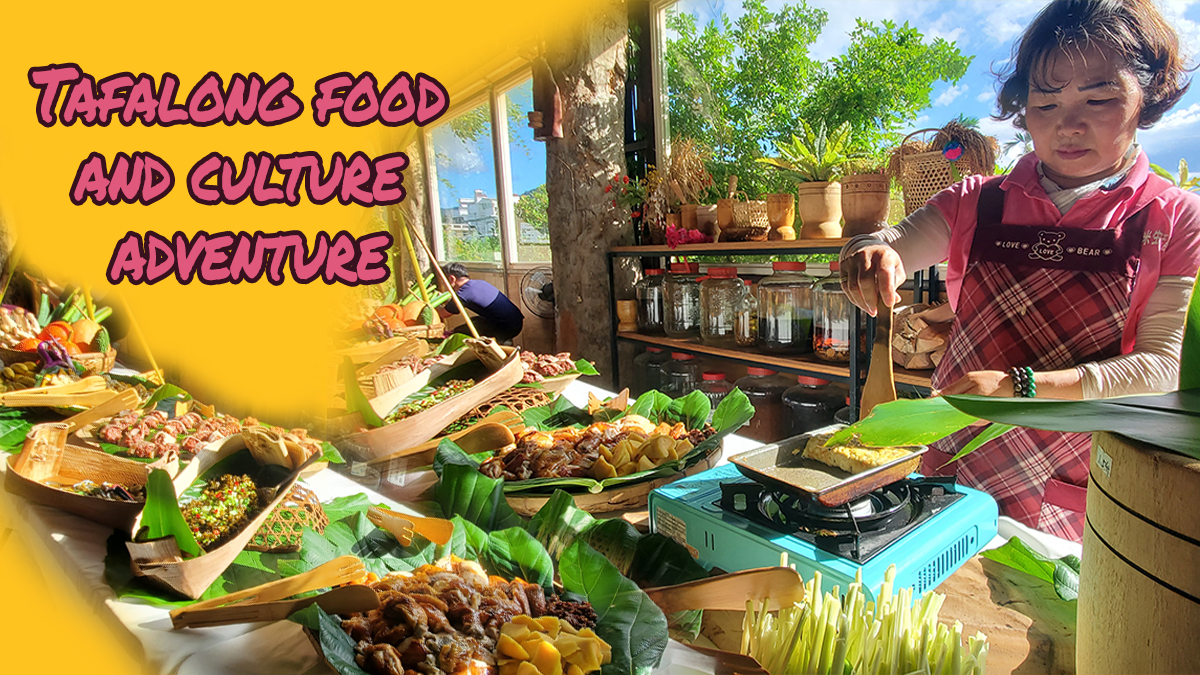Taiwan Observer recently had the honor of experiencing some of the most treasured traditions of the Tafalong community, as arranged by MyTaiwanTour.

Image courtesy of Wikipedia
The Tafalong community of the Amis tribe, the largest of the 16 officially recognized indigenous tribes in Taiwan, is primarily based in Guangfu Township of Hualien County, which neighbors the Guangfu River and the Mataian Settlement, another Amis community. Hualien is home to the largest concentration of indigenous people in Taiwan – namely, 200,000 of the 500,000 indigenous individuals scattered across the island; 5,000 of the 140,000 Amis tribesmen inhabit the Tafalong settlement today. The Tafalong community is among the oldest of its kind, its history stretching back some 2,000 years. Their folksy trademark handicrafts, ranging from vibrant textiles and pottery to exquisite wood carvings and bamboo work aside, the Tafalong people are famed for their cultivation of katepayi, or red glutinous rice – a crop exclusively grown in this region.
The Tafalong’s ancestors – also known as the “Taibalang,” a reference to the area’s abundance of white crabs and verdant rice paddies – originally hailed from the Fengbin Township in Maogong Mountain, roughly 23 kilometers southeast of Guangfu. According to Tafalong lore, they settled at Guangfu at the Sky God’s urging. In other accounts, their relocation was prompted by the rapidly swelling population and the exhaustion of arable land.

Image courtesy of Wikipedia
The Tafalong cherish the roots of their people just as they nurture the roots of their beloved crops. Once upon a time, as the legend goes, there lived a pair of siblings: a boy named Pilukalau and his sister, Marokirok, who resided in a land called “Karara.” Their peaceful lives in this little parcel of paradise, however, were disrupted by a ghastly flood that swept away all things in its path. The quick-thinking siblings managed to save themselves by launching themselves into a massive wooden mortar in the nick of time.
The currents carried their makeshift boat to a place called Tsatsulaan. It was here that the siblings eventually bore 12 children – six boys and six girls, whose descendants were the forefathers of the Vataan, Bunun, and Atayal tribes, as well as a subgroup of the Amis known as the “Nanshih Ami.” Meanwhile, two other sets of siblings made their escape from the flood in similar fashion. The first brother-and-sister pair, Tsihtsih and Patorau, who found refuge on a floating wooden partition, wound up in Amanlai. Lutsi and Lalakan from Kalapanapanai, distraught by the drowning of their other sister, drifted eastward to Tsilayasan. The two daughters of Lutsi and Lalakan were the progenitors of the Tafalong and Kiwit clans.
Tejamatsan, the literally glowing daughter of the gods Majau and Tsinatsinau, is said to have been the direct cause of the flood. In other versions of the story, Tejamatsan was not born to deities, but rather was the youngest daughter of a fourth-generation Tafalong family. Whatever the case, both Kodunkun, the god of thunder, and his brother Kalawatsan – the sons of the sea god Pansajan and the goddess Rijar – were resolved to make the breathtakingly beautiful maiden their bride. Majau and Tsinatsinau initially accepted Kodunkun’s proposal on their daughter’s behalf, their wedding scheduled to be held in five days’ time. Kalawatsan, who wanted Tejamatsan to himself, implored her parents to revoke their blessings, but they stood firm in their decision. Enraged yet undeterred, Kalawatsan proclaimed that he would, one way or the other, wed their daughter in two days.
True to his word, Kalawatsan arrived in Tsilayasan 48 hours later. Tsinatsinau scrambled to find a hiding place for Tejamatsan, stashing her in remote caves and deep in the mountains, but the inextinguishable beams of shimmering light that radiated from her daughter’s body rendered all her efforts futile. Kalawatsan soon found her and whisked her off to the east. Three days later, Kodunkun came to Tsilayasan, and upon learning about his missing fiancee, flew into a rage and conjured up a violent flood.




Our first stop was the Guangfu Wild Vegetable Market, which features the most diverse assortment of edible greens in all of Hualien. Every stall, each manned by a Tafalong local, was stocked with freshly-picked leafy greens and seaweeds, a rainbow of herbs and spices, and gourds of varying shapes and sizes. Certain vegetables such as the bitter gourd – bright green, somewhat lemon-shaped fruits covered in curious goose-pimply bumps – and the tire bitter gourd, reminiscent of miniature green pumpkins that fit in the palm of your hand, are only grown on Tafalong fields. Also for sale in at least one stall were mesh produce bags pulsating with dozens of tiny frogs.




Our guide was kind enough to teach us a few essential phrases in the Tafalong tongue, so that we could better interact with the indigenous vendors. “Nga’ayho,” we learned, is Tafalong for “Hello,” and “Aray” Tafalong for “Thank you.”




Next, we headed to the Tafalong Red Glutinous Rice House, where pre-prepared cooking stations, complete with pots, portable stoves, cooking utensils, and bamboo baskets filled with garden-fresh vegetables and ingredients awaited us.




Once we’d scoffed down our glutinous rice ball treats, each of which came with a distinctive savory punch, we made our own chili sauce and were each given Tafalong-style pompoms attached to some yarn to decorate our jars with.




We were then instructed on how to make our own salty pancakes from scratch, which we later stuffed with boiled greens, salted pork bits, and a healthy helping of other toppings and seasoning. We wrapped our rolled pancakes in ginger shell leaves, tied it together with bamboo husks and fuschias, and continued onward to our next stop.









We were brought to one of, if not the foremost Tafalong landmarks: the Kakita’an Ancestral House – a charmingly rustic, one-room structure fashioned out of rattan, wood, and bamboo, and crowned with a thatched straw roof. We even had the privilege of having Ms. Ko herself – a 59th-generation descendant of the Kakita’an family – show us around. In 1921, the Japanese authorities asked that the Kakita’an remove the dried, sun-baked heads that lined the roof, to which they complied; the heads were buried by a nearby hut. The house was officially declared a historic site in 1935.




Alas, the original structure was laid to waste by Typhoon Winnie in 1958. Seven ornamental panels, which featured carvings of the glowing daughter, the primeval flood, the customary headhunting practices, and other Tafalong traditions were salvaged by an anthropologist named Liu Pin-hsiung, who had them delivered to the Institute of Ethnology at Academia Sinica for safe-keeping. These panels were only returned to their rightful owners in 2003. The reconstruction of the ancestral house, based on the 1940 sketches of a Japanese architect, Chijiiwa Suketaro, started in earnest three years later.






Images courtesy of TELDAP
A delectable feast complemented by bottomless shots of rice wine, followed by an enchanting dance performed by an ensemble of lovely Tafalong ladies with infectious smiles, as well as a toron-making (pestle-pounded sticky mochi) session completed our experience.




Throughout the history of Taiwan, the indigenous communities of the island nation were made to endure centuries of unchecked abuse and neglect at the hands of the Dutch, Chinese, and Japanese colonizers – and yet, they persevered. Still, despite the increasing positive publicity surrounding Taiwan in recent years, these resilient indigenous tribes are often left out of the equation, which is, to put it bluntly, a downright shame, for they are an indispensable part of Taiwanese culture and heritage. It is therefore imperative that we do our part in helping to preserve and promote the precious and irreplicable cultures of our indigenous populations.






Sources:
http://nrch.culture.tw/twpedia.aspx?id=27154
https://www.erv-nsa.gov.tw/en/attractions/detail/78
https://taiwantoday.tw/news.php?unit=20,29,35,45&post=25557
https://www.dmtip.gov.tw/web/en/page/detail?nid=4
http://wandering-taiwan.blogspot.com/2010/09/hualien-jianwild-vegetable-market.html




Leave a comment